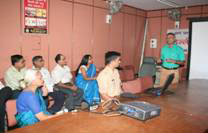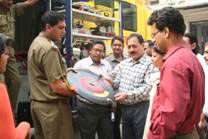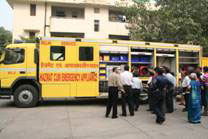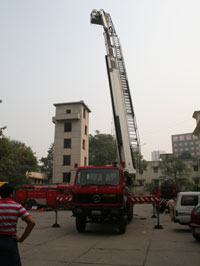IRCS, (DP & R) Studdents Visited the Delhi Fire Service
Nobody knew in the Neolithic Age that the evolution of fire would one day give sleepless nights to the humankind who would be compelled to have a fire extinguishing service to contain destruction caused by it. Fire in scientific terminology can be defined as “rapid burning of combustible material, producing heat and usually accompanied by flame”. It can start due to electrical short circuit, naked flame, hot surfaces, or exothermic reaction.
Controlling fire is a hard task management but the Delhi Fire Service, which was essentially established for this purpose in 1942, today has 42 fire stations, three disaster management centres and HAZMAT (Hazardous Material) Cum Emergency Appliance vehicles to deal with the emergencies.
The mock drill on fire safety measures in co-operation with Delhi Fire Service was organized for the students of Post Graduate Diploma Course in Disaster Preparedness & Rehabilitation, IRCS on November 4th, 2006. The fire drill gave exposure to students to enhance their alertness, preparedness and responding skills during fire accident. |
|
|
| |
|
|
| The Delhi Fire Service has a back up of approx. 1500 staff members out of which 1100 personnel are for fire services only. These firemen undergo six-months rigorous training at Fire Safety Management Academy, Rohini, New Delhii. The Delhi Fire Service has water tankers in its fire brigades which can store 5500 litres of water and the pressure of the hose propels |
|
 |
| |
|
|
| water upto 25-30 metres. They have Bronto Sky Lift which can go upto the height of 42 m above sea level. This is used mostly when floors of a higher building catch fire. Some students took a ride and experienced the aerial view of Delhi. They also have Simon Super Snorkel which can go upto the height of 60 m above sea level. Delhi Fire Service has 15 telephone lines for the universal number calling fire brigade, 101, with caller identification facility. They receive 16000-17000 calls in a year that makes 120-140 calls per day. 70-75% calls received are due to the fire caused by electrical short circuit. |
|
 |
| |
|
|
| The Delhi Fire Service also has a back up HAZMAT vehicles, used for fire the caused due to exothermic reaction. The vehicle carries pneumatic jack airbags, an accessory, which can pull around 20-23 tonnes of weight, hydraulic jacks, leak control kit, water gel blankets, fire detectors, torches, fire detector camera, hose of 90 metres, gas leakage detectors etc |
| |
|
|
| Mr. R.C. Sharma, Chief Fire Officer briefly stated that the Delhi Fire Service, Headquarters has strong connectivity with all its 42 fire stations in Delhi through wireless networking. He further mentioned that the Headquarters would soon upgrade its emergency response system by computerizing it. |
|
 |
| |
|
|
| The Station Officer, Mr. Mukesh Verma who headed the fire drill shared the motto of the Delhi Fire Service i.e. “First to save the life and second to save the property”. He mentioned that whenever a fire breaks out three steps are adopted and these are coding- to lower down the temperature, smothering- to cut the oxygen supply and segregation- to remove flammable material. He emphasised that preventing the fire breakout is essential before it takes the shape of a disaster. |
| |
|
|
The demonstration of extinguishing the fire by using the normal Fire extinguisher was also imparted to the students. Dr. Prannay K. Dutta, WHO, a student stated that fire drill was an experience in itself.
In normal life hardly one could know the functioning behind the fire brigades and secondly the live demonstration of using the fire extinguishers was enriching as it's essential for every individual to know. |
|
 |
|
